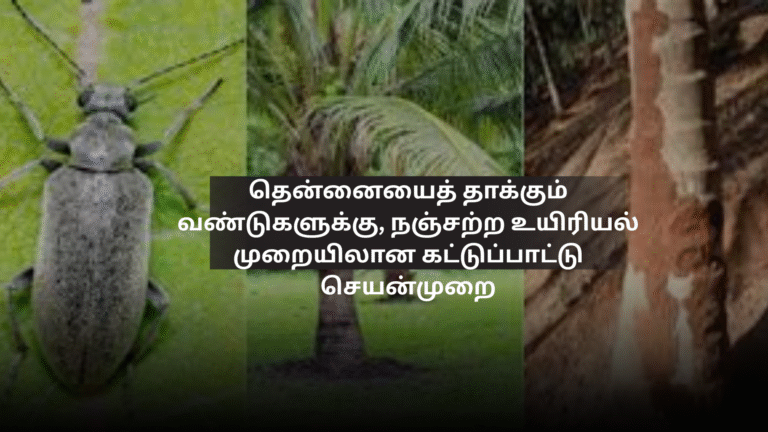தென்னையைத் தாக்கும் வண்டுகளுக்கு, நஞ்சற்ற உயிரியல் முறையிலான கட்டுப்பாட்டு செயன்முறை
🌴🐞🌴🐞🌴🐞🌴
தென்னை மரங்களில் பாதிப்பை ஏற்படுத்தும் வண்டுகளை கட்டுப்படுத்த நம் நாட்டில் பரவலாக நஞ்சு இரசாயன முறைகளே பரவலாக பயன்படுத்தப்படுகின்றன.
இந்த நச்சு இரசாயனங்களை பயன்படுத்தும் போது, சில மாதங்களுக்கு தேங்காய்களை, இளநீர்களை பயன்படுக்கூடாதென பரிந்துரை செய்யப்படுகிறது.
ஆனால் உள்ளூரில் விற்கப்படும் செவ்விளநீர் இவ்விதிமுறைகளைப் பின்பற்றி எல்லா இடங்களிலும் அறுவடை செய்யப்படுகிறதா என்பது கேள்விக்குறியே.
சில வருடங்கள் முன், நஞ்சு மருந்துகளை தென்னைக்கு விசிறிய போது, அருகிலிருந்த பாடசாலையில் படித்துகொண்டிருந்த சில மாணவர்கள் மயக்கமுற்று பாதிக்கப்பட்டு வைத்தியசாலையில் அனுமதிக்கப்பட்டு சிகிச்சை பெற்ற செய்திகள் உள்ளூர் ஊடகங்களில் வந்தமை பலரும் அறிந்ததே.
இவற்றுக்கு மாற்றாக, நுண்ணுயிரிகளைப் பயன்படுத்தி தயாரிக்கப்படும் உயிரிபீடைநாசினிகள், சிறந்த தீர்வு கொடுப்பவை, நஞ்சற்றவை, செயல்திறன் மிக்கவை.
நஞ்சற்ற நுண்ணுயிர் பூச்சிக்கொல்லியை, பயன்படுத்தி தென்னை வண்டுகளை கட்டுப்படுத்தும் பரிசோதனைகளை எமது சகோதரமொழி நண்பரான, தற்போது கனடாவிற்கு குடிபெயர்ந்து அங்கு நுண்ணுயிரியல் ஆராய்ச்சியாளராக பணிபுரியும் ஒருவரினால், எமது ஆலோசகராக உள்ள பயோடெக்னோலஜி நிறுவனம் ஒன்றினது அனுசரணையில் கிழக்கு மாகாணம் உள்ளிட்ட நாட்டின் பல பகுதிகளில், தனிப்பட்ட தெங்குதோட்ட உரிமையாளர்களின் விசேட அழைப்பின் பேரில் சில வருடங்கள் முன்பு நடத்தப்பட்டன.
தெங்கு முக்கோண வலயத்தின், குளியாப்பிட்டிய, குருநாகல், சிலாபம் பகுதி பாரிய தெங்குத் தோட்டங்களிலும், கண்டியிலும், கிழக்கில் வாகரை, மகாஓயா, மற்றும் கிழக்கை அண்டிய பகுதியான கிராந்துருகோட்டே பகுதியிலும் இவை தொடர்ச்சியாக 3 வருடங்களுக்கு மேல் பரிசோதிக்கப்பட்டது.
குருத்து /வட்டு மூலம், மரத்தை துளையிடாமல் இவை கொடுக்கப்பட்டன.
தென்னை இனத்தை பொறுத்து முதல் 12 – 15 வருடங்கள் மரங்களின் தண்டுகளின் வளர்ச்சி முற்றும் வரை ஒவ்வொரு மரமும் தனித்தனியாக அவதானிக்கப்படவேண்டும் என்பது தென்னந்தோட்டம் செய்யபவர்கள் யாவரும் அறிந்ததே.
தற்காலங்களில், வண்டு, குடம்பிகள் மரத்தில் உள்ளதைக் கண்டறிய, கருவிகள், விவசாயச் சந்தையில் தாராளமாக உள்ளன.
முறையாக வரவு செலவுக்கணக்கு எழுதப்படும் பட்சத்தில் ஓர் தோட்டத்தில், முறையான நன்கு பராமரிப்பிலுள்ள ஓர் மரத்துக்கு, தற்போதுள்ள பணவீக்க சூழ்நிலையில் பத்து வருடங்களில் கிட்டத்தட்ட ரூ 200,000 – 250,000 க்கு மேல் செலவிடப்படுகிறது என்பது தெரியவரும்.
வண்டுதாக்கமுற்று ஒரு மரமேனும் அழியும் பட்சத்தில், எமக்கு ஏற்படும் நட்டம் எமக்கு மிகவும் பெரியதே.
‘குருநாகல், புத்தளம் மாவட்டங்களை விடவும், கிழக்கில், பலருக்கு இன்னும் தென்னை மரத்தை பராமரிக்கும் அறிவு / செயன்முறை நுட்பங்கள் வெகுவாக மேம்படாமல் இருக்கின்றன’ என்று ஆய்வாளரால் எமக்குக் கூறப்பட்டது.
தென்னந்தோட்டம் சுத்தமாக இருக்கும் போது வண்டுகளின் தாக்கம் குறையும்.
இங்கு நிலவும் உயர் வெப்பநிலையும் உயிரியல் பீடைக்கட்டுப்பாட்டு ஆய்வில் வெகுவாக தாக்கம் செலுத்தியது.
உயிரிதொழிநுட்ப பீடை கட்டுப்பாட்டின் போது நஞ்சு இரசாயனங்கள் தெளிக்கப்படக்கூடாது எனும் கண்டிப்பான நிபந்தனை விதிக்கப்பட்டது. ஏனெனில் நச்சு இரசாயனங்கள் உள்ள சூழ்நிலையில் நன்மை செய்யும் நுண்ணுயிர்கள் பல்கிப்பெருகாது.
நுண்ணுயிரிக் கலவை 150 மில்லிலீட்டர் இனை ஒரு லீட்டர் நீரில் கரைத்து ஓர் புனலை வைத்து, வட்டினுள் / குருத்தினுள் செலுத்தப்பட்டது. (முன்னர் பவுடர் வடிவில் இருந்த இவை தற்போது நிறமற்ற திரவ வடிவில் மாற்றப்பட்டுள்ளது )
மேலும் 100 மில்லி நுண்ணுயிரிக் கலவையினை, ஒன்றரை லீட்டர் நீருடன் கலந்து வேர் பகுதியில் சுற்றி வர ஊற்ற வேண்டும்.
முதன்முறை செய்யும் போது மட்டும் 14 நாட்களில் திரும்ப செய்ய வேண்டும்.
பின்னர் மூன்று மாதங்களுக்கு ஒருமுறை இவ்வாறு கொடுத்துவந்தால் போதுமானது.
இச்செயன்முறைக்கு தோட்டம் பராமரிப்பவரின் அர்ப்பணிப்பு அதிகம் தேவை.
மழை காலங்களின் போது, இவை கரையாமல் இருக்க பசைப்பிடித்திருப்பான்களுடன் (gumming agents) கலந்து உபயோகிக்கலாம். இந்த முறையில் 3 வருடங்கள் தொடர் அவதானிப்புகளில் குறிப்பிடத்தகு பலன் கிடைத்தது.
பரிசோதனைக்கு உட்படுத்தப்பட்ட 700 மரங்களில், 3 வருடங்களில் மொத்தமாக 11 மரங்கள் மட்டுமே பாதிக்கப்பட்டிருந்தன. இவற்றில் 3 மரங்கள் பைட்டோபிளாஸ்மா நோய்த்தாக்கத்திற்கு உட்பட்டிருந்தன போக, மீதி 8 மரங்கள் அதிலும் குறிப்பாக வாகன போக்குவரத்துக்குட்பட்ட பெருவீதியை அண்டி நடப்பட்டிருந்த மரங்களே பெரும்பாலும் வண்டுத்தாக்கத்துக்கு உட்பட்டிருந்தன. இவற்றுக்கான காரணம் சரியாக அறியப்படவில்லை.
பராமரிப்பாளரின் அனுபவமின்மை மற்றும் கவனகுறைவும் மற்றுமொரு காரணமாகவும் இருக்கலாம்.
நுண்ணங்கிகள் பல்கிப்பெருக, வெப்ப நிலையை பொறுத்து, 3 தொடக்கம் 7 நாட்கள் தேவை என்பதால், வண்டு தாக்கியபின் சிகிச்சை கொடுப்பது குறைந்த பலனையே தரும். உயிரியல் முறையில் எப்போதும் வருமுன் காப்பதே சிறந்தது.
மேலும் இம்முறை செலவு குறைவானது. ஒரு மரத்துக்கு மூன்று மாதங்களுக்கான செலவு, இரண்டு தேங்காய்களின் தற்போதைய சந்தை விலை அளவே காணப்படுகிறது.
இம்முறையில், மரத்தில் காயமேற்படாது. அதனால் வண்டு மரத்தை தேடி வருவது குறையும்.
தாவரத்தின் உள் சென்ற நுண்ணுயிர்கள் தாவரம் உள்ளேயே பல்கிப்பெருகி, வண்டுகளிலும், குடம்பிகளிலும் Muscardine disease எனும் பாதிப்பை உண்டாக்கி அவற்றை அழிக்கிறது. இவற்றால் தாக்கப்படும் செவ்வண்டின் குடம்பிகள் / புழுக்கள் இயங்க முடியாமல், தென்னையின் உள்தண்டை உண்ண முடியாநிலைக்கு வந்து, ஈற்றில் அழிகின்றன.
இந்திய, தென்கிழக்காசிய மற்றும் பல ஐரோப்பிய நாடுகள் இவற்றை அங்கீகரித்து பல தசாப்தங்களாகப் பாவித்து வருகின்றனவாயினும், இன்னும் இலங்கையில், நுண்ணுயிர் பீடை கட்டுப்படுத்திகளுக்குரிய அங்கீகாரம் வழங்கப்படுவதைத் தாமதப்படுத்தும் போக்கே இங்கு காணப்படுகிறது.
மேலதிக விபரங்களுக்கு
CSJ Agri
076 225 0017
மேலதிக தகவல்களுக்கு மாற்றம் செய்திகள் இணையத்தளத்தினுள் பிரவேசியுங்கள்.
மேலதிக தகவல்களை உடனுக்குடன் பெற்றுக்கொள்ள மாற்றம் செய்திகள் முகநூல் பக்கத்தை பின்தொடரவும்.
Biological, Non-Toxic Method to Control Coconut Beetles
🌴🐞🌴🐞🌴🐞🌴
In Sri Lanka, chemical pesticides are widely used to control beetles that damage coconut trees. However, these toxic substances make coconuts and king coconuts unsafe for consumption for several months after spraying. Unfortunately, it’s uncertain whether all local sellers of king coconuts strictly follow these safety guidelines.
A few years ago, there were media reports of students fainting and being hospitalized after pesticide spraying on nearby coconut plantations. Such incidents highlight the dangers of chemical-based pest control.
As an alternative, biological pesticides made using microorganisms have proven to be an effective, non-toxic, and environmentally friendly solution.
Research using a microbial bio-pesticide to control coconut beetles was conducted several years ago in different regions of Sri Lanka, including the Eastern Province, under the guidance of a Sri Lankan microbiologist now working in Canada. The trials were carried out with the support of a biotechnology firm and the participation of local plantation owners.
Field trials were conducted continuously for over three years in major coconut-growing regions such as Kuliyapitiya, Kurunegala, Chilaw, Kandy, Vakarai, Maha Oya, and Girandurukotte (on the eastern border).
The treatment was administered without drilling holes into the trees, using the root or trunk injection method.
Every coconut tree, especially during the first 12–15 years, needs close monitoring until full trunk maturity. Tools to detect beetle or grub infestations are now widely available in agricultural markets.
Detailed financial records from well-maintained estates show that, under current inflationary conditions, maintaining a single coconut tree for ten years can cost LKR 200,000–250,000. Therefore, losing even a single tree to beetle damage results in a significant economic loss.
According to the researcher, knowledge and technical practices related to coconut cultivation are still less developed in some eastern regions compared to Kurunegala and Puttalam.
Maintaining a clean and well-managed plantation reduces beetle infestations. The high temperatures in these areas were found to significantly influence the performance of biological control methods.
A strict rule was followed during the trials: no chemical pesticides were used simultaneously. This is because beneficial microbes cannot multiply in the presence of toxic chemicals.
The microbial mixture was prepared by mixing 150 ml of culture in 1 liter of water, and applied into the trunk cavity (through a groove or root zone) using a funnel. (Previously available in powder form, it has now been improved into a colorless liquid.)
Additionally, 100 ml of the same mixture was diluted in 1.5 liters of water and poured around the base of the tree.
The second application was given 14 days after the first, and then every three months thereafter. Consistent care by plantation workers was essential for success.
During rainy periods, gumming agents were added to prevent the mixture from washing away. After three years of continuous observation, the results were remarkable — only 11 out of 700 trees were affected. Of these, three trees had phytoplasma disease, and the remaining eight were located along busy roads, suggesting possible environmental stress or carelessness as contributing factors.
Microbes generally take 3–7 days to multiply depending on temperature, so preventive use is more effective than reactive treatment.
The biological control method is also cost-effective — the three-month treatment cost per tree is about the value of two coconuts in today’s market.
This process causes no physical injury to the tree, reducing the likelihood of beetle attraction. The microbes enter the tree, multiply, and cause a Muscardine disease in the beetles and grubs, paralyzing and eventually killing them.
While this method has long been approved and used in India, Southeast Asia, and several European countries, Sri Lanka has yet to officially recognize microbial bio-pesticides for widespread agricultural use.
📞 For more information:
CSJ Agri
📱 076 225 0017



